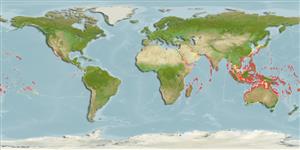Environment: milieu / climate zone / depth range / distribution range
Ecologia
marinhas associadas(os) a recifes; intervalo de profundidade 2 - 40 m (Ref. 48637), usually 10 - ? m. Tropical
Indo-Pacific: East Africa to Micronesia (excluding the Marshall Islands), north to the Ryukyu Islands, south to the Solomon Islands and the Great Barrier Reef. Range extending to Rangiroa Atoll, Tuamotu Archipelago.
Tamanho / Peso / Idade
Maturity: Lm ? range ? - ? cm
Max length : 40.0 cm FL macho/indeterminado; (Ref. 9710); common length : 25.0 cm FL macho/indeterminado; (Ref. 9710)
Espinhos dorsais (total) : 4; Raios dorsais moles (total) : 28 - 30; Espinhos anais: 2; Raios anais moles: 27 - 29. Body elongate-ovate. Dorsal and anal profiles nearly even. Forehead without rostral prominence when in adults. Peduncular plate single, with a semicircular, retrorsely curved keel. Reaches 35 cm SL.
Generally uncommon species found in steep outer lagoon and seaward reef slopes (Ref. 9710, 48637). Maximum depth reported at 40m (Ref. 37792) Occurs singly or in large schools (Ref. 9710, 48637). Usually seen swimming steadily along upper edges of drop-offs in pursuit of plankton (Ref. 48637). A semi-pelagic fish that feeds on zooplankton, but remains over or near reefs. Also feeds on algae (Ref. 30573). It is cleaned by Labroides and sleeps on reefs at night, taking on a disruptive mottled pattern (Ref. 10671). Caught with nets (Ref. 30573).
Life cycle and mating behavior
Maturities | Reprodução | Spawnings | Egg(s) | Fecundities | Larvas
Randall, J.E., 1994. Unicornfishes of the subgenus Axinurus Perciformes: Acanthuridae: Naso), with description of a new species. Copeia 1994(1):116-124. (Ref. 10671)
Categoria na Lista Vermelha da IUCN (Ref. 130435)
Ameaça para o homem
Harmless
Utilização humana
Pescarias: espécies comerciais; Aquário: Espécies comerciais
Ferramentas
Relatórios especiais
Descarregue XML
Fontes da internet
Estimates based on models
Preferred temperature (Ref.
123201): 24.7 - 29, mean 27.7 °C (based on 470 cells).
Phylogenetic diversity index (Ref.
82804): PD
50 = 0.5000 [Uniqueness, from 0.5 = low to 2.0 = high].
Bayesian length-weight: a=0.01950 (0.01114 - 0.03412), b=3.09 (2.94 - 3.24), in cm total length, based on LWR estimates for this species & Genus-body shape (Ref.
93245).
Nível Trófico (Ref.
69278): 3.0 ±0.32 se; based on food items.
Resiliência (Ref.
120179): Médio, tempo mínimo de duplicação da população 1,4 - 4,4 anos (Preliminary K or Fecundity.).
Fishing Vulnerability (Ref.
59153): Low to moderate vulnerability (34 of 100).
Nutrients (Ref.
124155): Calcium = 42.7 [26.3, 73.0] mg/100g; Iron = 0.552 [0.287, 0.947] mg/100g; Protein = 19 [18, 20] %; Omega3 = 0.139 [0.094, 0.248] g/100g; Selenium = 31 [18, 49] μg/100g; VitaminA = 70.4 [28.1, 175.2] μg/100g; Zinc = 1.3 [0.9, 1.8] mg/100g (wet weight);
